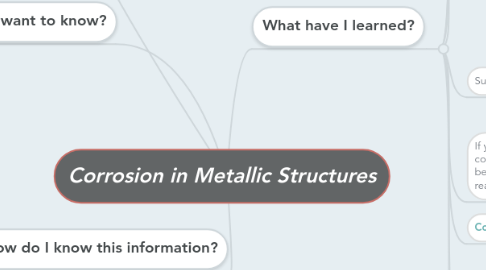
1. What do I know?
1.1. Corrosion is the reaction of a metal with oxygen in its environment (water, salt) to form a metal oxide.
1.1.1. Rust is a type of corrosion. It refers specifically to the corrosion of iron (or steel)
1.1.2. Corrosion can be accelerated from environmental features
1.2. One major cause to many infrastructure facilities deteriorating is inattention to corrosion control as an overall maintenance program
1.3. Corrosion protection and control
1.3.1. Coatings and linings
1.3.2. Corrosion-resistant materials
1.3.3. Corrosion inhibitors and substances that decrease the rate of attack from the environment
2. What do I want to know?
2.1. Are there any types of metals are strong enough to support infrastructure, but will not corrode?
2.2. Have any new technologies been created that can counteract corrosion?
2.3. What substances can protect from corrosion?
2.4. Corrosion can only happen if there is oxygen around. Is there a way to limit the amount of oxygen that reaches the metals?
2.5. What steps can be taken to prevent corrosion after the structures have been built?
2.6. What countries have poor infrastructure because of corrosion that can be fixed?
3. How do I know this information?
3.1. NACE International PDFs
3.2. Aluminum Anodizers Council
3.3. Education Perfect
3.4. Home Science Tools
3.5. AMMA Resource Industry Employment Group
3.6. Boundless.com
3.7. Business Standard Newspaper
4. What have I learned?
4.1. Noble metals (such as copper, palladium, silver, platinum, gold) are pretty unreactive, and therefore don't corrode as easily
4.2. Bronze is resistant to corrosion from sea water
4.3. Titanium is lighter and just as strong as steel. It is also very resistant to corrosion. It is heavier than aluminum but twice as strong.
4.3.1. Titanium has the highest strength-to-weight ratio out of all the known metals.
4.3.2. The largest producer of titanium is Australia.
4.3.3. Titanium has many uses including jewellery making, aerospace components and submarines.
4.4. Anodization is an electrochemical process that converts the metal surface into a decorative, durable, corrosion-resistant, anodic oxide finish.
4.4.1. it cannot chip or peel
4.4.2. ultimately creates an end product whose finish is more durable and weather-resistant.
4.4.3. has been used in the NASA Space Station and can also be used in commercial, industrial, and consumer applications, even jewelry and artwork.
4.4.4. Anodizing is both aesthetically pleasing and has functional befinits of increased durability which offer numerous design opportunities for architects, builders, product designers and specifiers, and more
4.4.5. The resultant protective layer is very hard and very resilient
4.5. Substances to protect from corrosion:
4.5.1. Sacrificial coating is a metal coating that is more likely to be oxidized than the metal it protects.
4.5.2. Galvenising is to coat with a thin layer of metal by electrochemical means; to electroplate
4.6. If you wanted to limit the amount of oxygen in a building, it would stop corrosion, but humans would not be able to go into that building because it would be almost impossible to breathe. Therefore, this is really impractical and not a good solution.
4.7. Corrosion inhibitors
4.7.1. A corrosion inhibitor is any substance which effectively decreases the corrosion rate when added to an environment.
4.8. Maintenance
4.8.1. Preventive maintenance refers to repair and maintenance actions before a failure occurs. Scheduled inspections for corrosion damage feature prominently, to facilitate these preemptive actions.
4.8.2. Corrective maintenance can be described as "fixing" when a problem occurs. This maintenance strategy is reactive only, and corrosion monitoring programs do not feature prominently in this approach.
4.8.3. Predictive maintenance actions are based on the actual condition, rather than on fixed schedules. Corrosion sensors and monitoring activities are important in the context of creating a "smart structure", for obtaining information on its actual condition.

